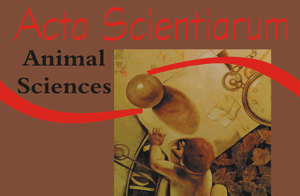Resumo em Português:
RESUMO. A pesquisa objetivou determinar o índice de conforto térmico mais adequado para búfalos criados na Amazônia Oriental, Pará, Brasil. Foram utilizados vinte búfalos Murrah. Foram registrados dados de variáveis climáticas e temperatura retal (TR), temperatura da superfície corporal (TSC) e frequência respiratória (FR), e foram calculados os índices: Índice de Temperatura e Umidade (ITU), Índice de Temperatura de Globo e Umidade (ITGU), Índice de Conforto Térmico de Benezra (ICB), Índice de Tolerância ao Calor de Ibéria (ITCI), Índice de Condições Climáticas de Conforto para búfalos geral (BCCCIg), efetivo (BCCCIe) e prático (BCCCIp) e Índice de Conforto Ambiental para búfalos geral (BECIg), efetivo (BECIe) e prático (BECIp), nos períodos da manhã e da tarde. Foram observados valores de ITU, ITGU, TR, TSC, FR, ICB, BCCCIg, BCCCIe, BCCCIp, BECIg, BECIe e BECIp mais elevados à tarde. Os maiores valores de ITCI foram encontrados de manhã. Houve correlação positiva entre as variáveis fisiológicas e ITU, ITGU, ITCI, BCCCIg, BECIg, BCCCIe, BECIg, BCCCIe, BECIp, enquanto uma correlação negativa foi encontrada para TR e TSC com ITCI. Os índices THI, GTHI, BCCCIg, BECIg, BCCCIe, BECIe, BCCCIp e BECIp são eficientes para avaliar o estado de conforto térmico dos búfalos na Amazônia Oriental.
Resumo em Inglês:
ABSTRACT. This research aimed to determine the most appropriate thermal comfort index for buffaloes reared in the Eastern Amazon, Pará, Brazil. Twenty male Murrah buffaloes were used, and data on climate variables, rectal temperature (RT), body surface temperature (BST), and respiratory rate (RR) were recorded. Subsequently, the following indices were calculated: Temperature and Humidity Index (THI), Global Temperature and Humidity Index (GTHI), Benezra’s Thermal Comfort Index (BTCI), Ibéria’s Heat Tolerance Index (IHTI), the general, effective, and practical Buffalo Comfort Climatic Conditions Indices (BCCCIg, BCCCIe, and BCCCIp, respectively) and the general, effective, and practical Buffalo Environmental Comfort Indices (BECIg, BECIe, and BECIp, respectively) in the morning and afternoon. Higher values for THI, GTHI, RT, BST, RR, BTCI, BCCCIg, BCCCIe, BCCCIp, BECIg, BECIe, and BECIp were observed in the afternoon, and the highest IHTI values were found in the morning. A positive correlation was found among the physiological variables and THI, GTHI, BTCI, BCCCIg, BECIg, BCCCIe, BECIe, BCCCIp, BECIp, while a negative correlation was found for RT and BST with IHTI. The indices THI, GTHI, BCCCIg, BECIg, BCCCIe, BECIe, BCCCIp, and BECIp were determined to be very efficient to assess the thermal comfort status of buffaloes under the conditions of the present research.
